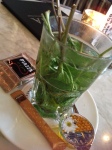Lately I discovered a very inspiring blog from the Dutch-Indonesian Nicole Holten, now living in Idaho, about Dutch food, The Dutch Table. I higly recommend this site to everyone looking for a traditional Dutch food recipe!
Most people think that the Dutch don’t have a proper (whatever this means!) culinary tradition. Well, actually they did cook very interesting dishes until the beginning of the 19th century “when frugality became fashionable”. In her very interesting article “The History of Dutch Food”, Karin Engelbrecht points out that: “The classic Dutch cookbook, De Verstandige Kok (The Sensible Cook), published in 1669, includes recipes for roast goose with turmeric root and queekoeckjens, candies made from quince paste. Adventurous even by today’s standards”. And in another article, she also lists up some traditional Dutch recipes.
As everyone knows, the Dutch ruled the spice trade for a hundred years and you can still find a great variety of spices on the markets and stores. I’m not going to list up all the typical Dutch dishes.
Here are 8 foods that you should try if you are in the Netherlands:
1) Poffertjes are small pancakes made with yeast and buckwheat flour. They are made in a special pan and served with butter and powdered sugar.
2) Boterham met Hagelslag: Since my children went to the Dutch daycare (creche), they were used to eat boterham at lunch (a slice of bread with some savoury and/or sweet topping). We very soon got used to like the Hagelslag, a sort of sprinkels (but a bit bigger than those people put on ice cream) that adults and children put on their buttered bread at breakfast.
3) Muisjes: The muisjes (little mice) are candied anise seeds that come either white and pink or white and blue and usually are the first thing a mum is given to celebrate the birth of her child on an beschuit (rusk). The anise in the muisjes is thought to stimulate lactation and the muisjes symbolize fertility. It’s actually a tradition since the 17th century, that the parents of a newborn baby offer beschuit met muisjes to the baby’s visitors. When I gave birth to my twingirls, this was the first thing they offered me in the hospital. I found it a very nice gesture. – But obviously you can also eat it every day for breakfast… or the gestampte muisjes, a grinded version of the muisjes, created for elder people who find it more difficult to bite the muisjes.
4) The Stroopwafeln (a syrup wafle see a great recipe here) from Gouda are very delicious! It’s a waffle, made from two thin layers of baked batter with a caramel-like syrup filling in the middle.
5) The Limburgse vlaai is a sweet pie with a light crust. It is filled with cherries or apricots and comes originally from the Limburg area in the south of the Netherlands. The dough is different from a pie, lighter and quite thin. You can find several varieties of vlaai throughout the Netherlands. Usually they are filled with fruit, but the greumellevlaai is filled with a buttery crumble mix and a rice pudding recipe called rijstevlaai.
6) The Snert (also known as „echte Hollandse Erwtensoep“) is the Dutch version of split pea soup. The soup contains split peas, carrots, celery, onion, bay leaf, sometimes potatoes etc. and is usually served with smoked sausage. – This is a typical winter dish, a really delicious warming meal!

7) The Hollandse Haring is a raw herring fish, typically served with chopped onions. You can eat it with (broodje haring) or without bread. If caught between May and July, it’s called Hollandse nieuwe.
8) The Stamppot is traditionally served during winter time. It consists of mashed potatoes mixed with kale or carrots and usually served with rookworst (smoked sausage).
Eet smaakelijk! (enjoy your meal!)
****
And as beverage, along with the typical beer etc., I recommend to try the verse muntthee, a delicious tea with fresh mint, served with honey in a big glass.

Categories: Culture/Traditions, Netherlands, The Hague






Baklever, Smolt, Zeekraal, Filosoof, Hacheé and Hete Bliksem…
I still cannot eat, for love or money, even after living here for 25 years, hagelslag, haring, Hema slagroom taart, or that stingy man’s favorite, half om half gehakt.
Erm… muntthee is actually a Moroccan tradition.
LikeLike
Hi Misirlou, thanks for stopping by! I can understand, It’s a matter of taste. I don’t like half om half gehakt and the Hema slagroomtaart neither. I know, the muntthee is not really Dutch, but what I like, is that you can get it everywhere and I really enjoy this “adoption” 😉
LikeLike
Just being silly about the muntthee…I like it too, in the summertime.
Have you tried schorseneren yet?
LikeLike
Schorseneren met witte saus? Yes ;-), it’s something my mum and my grandma made regularly (it’s also known in Germany): “Schwarzwurzeln in holländischer Sauce”.
LikeLike
#5 and #8 look very appealing. Even though I normally love herring, I can’t see myself eating #7. :>) Speaking of herring, it’s always been my understanding that this modest fish, along with generations of hard work, were what gave the ‘Dutch’ the wealth to move toward empire.
LikeLike
Thanks for stopping by, Maurice. You can also eat the herring in a more “traditional way” with bread and onions. I assure you that it’s a very dainty fish. As for the salt herring, it’s thanks to Willliam Buckels of Biervliet, who in the late 14th century discovered that fish can be kept fresh with the help of salt, that the Dutch monopolized the export industry for salt herring. Here you can find a short description: http://en.wikipedia.org/wiki/Gibbing.
LikeLike
I’m familiar with the salt-curing technique as I’m from Newfoundland. Around about that same time the Basque and Portuguese fishermen came across the cod-rich Grand Banks. In 1497 when Giovanni Caboto or Zuan Chabotto or John Cabot or whatever you want to call him ‘discovered’ Newfoundland, what he likely really did was to blow the lid off a well-kept trade secret. At any rate we followed the same example and worked away–the hard way–to build a way of life that we all loved, and continue to do so today!
LikeLiked by 1 person
the sweets at the top look interesting. But 6,7 and 8 do not appeal to my Italian tastebuds…
LikeLike
Haha, I have Italian tastebuds too 😉 Well, the Erwtensoep can be compared to the Italian minestroni (but my favourite is the ribollita) and the Stamppot is like purè di patate mixed with vegetables.
LikeLike
What an interesting post. I like # 5 and #6 best. I don’t normally like anything sweet, but fruit pies are my favorite.
LikeLike
Thanks, I’m still discovering new Dutch dishes and flavours. What I like in the Netherlands is also the variety of international restaurants. – Thanks for stopping by! 😉
LikeLike
I love poffertjes, stroopwaffels, and appeltaart! Not such a fan of beschuit met muisjes, though. And snert, and I sometimes make it myself, and the nieuwe haringe are also delicious! It seems that the Dutch are better at doing sweets than savories…And you forgot the kipsate met pindasauce! Thanks for the article and for the interesting history- I was also wondering how a nation with such power and access to the best spices could end up with food that is boring…
LikeLike
Yes, and I forgot the bitterballen, the appeltaart, the Kibbeling, the kroket, the cheese-universe, the oliebollen etc. I just listed some of those I really got to like. Well, the lekkerbekjes and the vla are pretty yummy too… On Nicole Holten’s page you can find plenty of good recipes. Anyway, Dutch cooking is straight-forward, easy to make, cheap and nutritious and basically rely on vegetables and legumes.
LikeLike
We are a gaggle of volunteers and opening a new scheme in our community.
Your website offered us with useful info to work on. You have done a
formidable process and our entire community shall be thankful
to you.
LikeLike